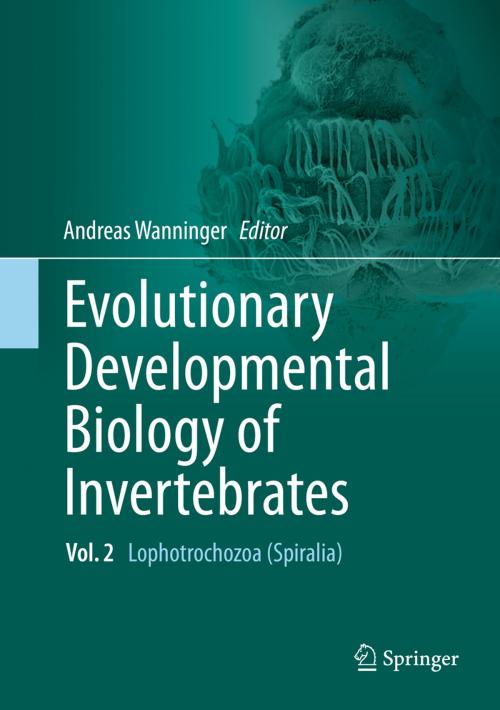Evolutionary Developmental Biology of Invertebrates 2
Lophotrochozoa (Spiralia)
Nonfiction, Science & Nature, Science, Biological Sciences, Zoology| Author: | ISBN: | 9783709118719 | |
| Publisher: | Springer Vienna | Publication: | August 10, 2015 |
| Imprint: | Springer | Language: | English |
| Author: | |
| ISBN: | 9783709118719 |
| Publisher: | Springer Vienna |
| Publication: | August 10, 2015 |
| Imprint: | Springer |
| Language: | English |
This multi-author, six-volume work summarizes our current knowledge on the developmental biology of all major invertebrate animal phyla. The main aspects of cleavage, embryogenesis, organogenesis and gene expression are discussed in an evolutionary framework. Each chapter presents an in-depth yet concise overview of both classical and recent literature, supplemented by numerous color illustrations and micrographs of a given animal group. The largely taxon-based chapters are supplemented by essays on topical aspects relevant to modern-day EvoDevo research such as regeneration, embryos in the fossil record, homology in the age of genomics and the role of EvoDevo in the context of reconstructing evolutionary and phylogenetic scenarios. A list of open questions at the end of each chapter may serve as a source of inspiration for the next generation of EvoDevo scientists. Evolutionary Developmental Biology of Invertebrates is a must-have for any scientist, teacher or student interested in developmental and evolutionary biology as well as in general invertebrate zoology.
This volume covers the animals that have a ciliated larva in their lifecycle (often grouped together as the Lophotrochozoa), as well as the Gnathifera and the Gastrotricha. The interrelationships of these taxa are poorly resolved and a broadly accepted, clade-defining autapomorphy has yet to be defined. Spiral cleavage is sometimes assumed to be the ancestral mode of cleavage of this grouping and therefore the clade is referred to as Spiralia by some authors, although others prefer to extend the term Lophotrochozoa to this entire assemblage. Aside from the taxon-based chapters, this volume includes a chapter that highlights similarities and differences in the processes that underlie regeneration and ontogeny, using the Platyhelminthes as a case study.
This multi-author, six-volume work summarizes our current knowledge on the developmental biology of all major invertebrate animal phyla. The main aspects of cleavage, embryogenesis, organogenesis and gene expression are discussed in an evolutionary framework. Each chapter presents an in-depth yet concise overview of both classical and recent literature, supplemented by numerous color illustrations and micrographs of a given animal group. The largely taxon-based chapters are supplemented by essays on topical aspects relevant to modern-day EvoDevo research such as regeneration, embryos in the fossil record, homology in the age of genomics and the role of EvoDevo in the context of reconstructing evolutionary and phylogenetic scenarios. A list of open questions at the end of each chapter may serve as a source of inspiration for the next generation of EvoDevo scientists. Evolutionary Developmental Biology of Invertebrates is a must-have for any scientist, teacher or student interested in developmental and evolutionary biology as well as in general invertebrate zoology.
This volume covers the animals that have a ciliated larva in their lifecycle (often grouped together as the Lophotrochozoa), as well as the Gnathifera and the Gastrotricha. The interrelationships of these taxa are poorly resolved and a broadly accepted, clade-defining autapomorphy has yet to be defined. Spiral cleavage is sometimes assumed to be the ancestral mode of cleavage of this grouping and therefore the clade is referred to as Spiralia by some authors, although others prefer to extend the term Lophotrochozoa to this entire assemblage. Aside from the taxon-based chapters, this volume includes a chapter that highlights similarities and differences in the processes that underlie regeneration and ontogeny, using the Platyhelminthes as a case study.















